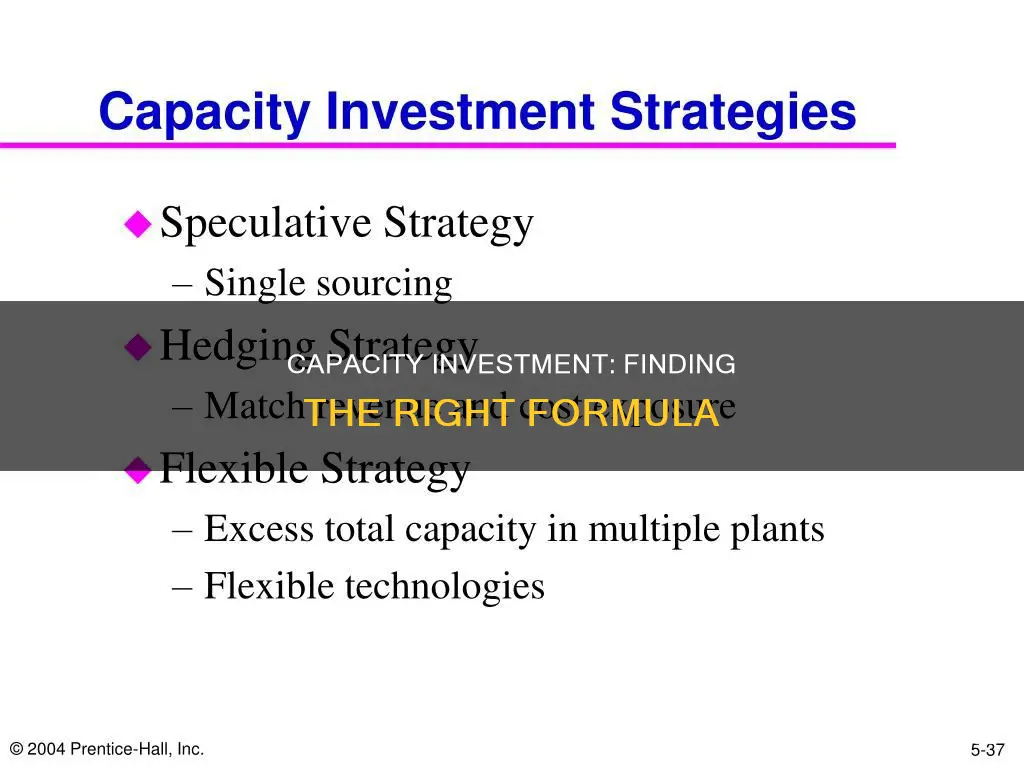
The capacity utilization rate is a key metric for businesses to understand their operational efficiency and determine how well they are reaching their potential. It is calculated by dividing the actual output by the potential output and multiplying by 100. A rate of 100% indicates perfect efficiency, but this is not always realistic or desirable due to factors such as supply chain disruptions, demand fluctuations, and manufacturing challenges. A high capacity utilization rate can also signal to businesses that they need to invest in new equipment to increase their production capacity.
Businesses can increase their capacity utilization rate by investing in new production lines, expanding their facilities, or hiring more employees. However, it is important to first identify the factors limiting capacity utilization, such as a lack of raw materials or fluctuating market conditions.
| Characteristics | Values |
|---|---|
| Formula | (Actual Output / Potential Output) x 100 = Capacity Utilization Rate |
| Actual Output | The real, tangible production or output that an organization has achieved within a specific timeframe |
| Potential Output | The theoretical maximum production that could be achieved under ideal conditions |
| Capacity | The maximum level of output that a company can sustain to make a product or provide a service |
| Capacity Utilization Rate | Measures the percentage of an organization's potential output that is actually being realized |
| Slack | The percentage of capacity the company could not use |
| Gross Investment | The sum of expenditures for new capital purchases and the replacement of depreciated capital |
| Net Investment | Only includes adding new capacity |
| Bottlenecks | A point of congestion in a production system that prevents the system from functioning at full speed |
| Capacity Managers | Handle external goods or services, manage a more technical type of capacity, or manage employees |
What You'll Learn

The capacity utilization rate formula
The capacity utilization rate is a key metric for businesses to assess their operational efficiency and determine their realized potential output. It is calculated using the following formula:
Capacity Utilization Rate = (Actual Output / Potential Output) x 100
The formula compares the actual output produced by a company to its maximum output capacity within a given period. This could be calculated for a month, a quarter, or a year. The actual output refers to the real, tangible production achieved by the company, while the potential output is the theoretical maximum production that could be achieved under ideal conditions.
For example, a manufacturing company that produces 800 units of a product in a month but has the capacity to produce 1,000 units would have a capacity utilization rate of 80%. This indicates that the company is operating at 80% of its maximum potential output.
The capacity utilization rate is valuable for businesses as it helps them understand their efficiency and identify areas for improvement. A rate below 100% suggests that the company can increase its production without investing in new equipment, while a rate above 100% indicates that operations are running over capacity. Ideally, a company would aim for a capacity utilization rate close to 100% to maximize its profit margins. However, this may not always be realistic due to various constraints such as supply chain disruptions or fluctuations in demand.
Capacity utilization rates also have broader economic implications. Policymakers analyze these rates to inform fiscal and monetary policies, particularly in industries that produce physical products. For instance, in the US, the Federal Reserve tracks capacity utilization rates in 89 industries within the mining, manufacturing, and utility sectors.
Bahamas: Foreign Investment Origins
You may want to see also

The impact of capacity investment on operational efficiency
The capacity utilization rate is a key metric for businesses to assess their operational efficiency. It is calculated by dividing the actual output by the potential output and multiplying by 100. A rate of 100% indicates perfect efficiency, but this is not always viable or realistic due to disruptions and fluctuations. A safe zone for businesses is usually between 80-85%, as it allows for high output and production while retaining the ability to accommodate surges in demand.
Capacity investment can have a significant impact on operational efficiency. Firstly, it allows businesses to increase their production capacity and meet higher demand. This can be achieved by investing in new equipment, expanding facilities, or hiring more personnel. For example, a manufacturing company may need to purchase additional machinery to increase its output.
Secondly, capacity investment can help businesses optimize their resource allocation and improve overall efficiency. By investing in advanced technology and analytics tools, businesses can make data-driven decisions to allocate resources effectively, preventing bottlenecks and ensuring smooth operations.
Additionally, capacity investment can enable businesses to fine-tune their operational processes, improve quality, and reduce lead times. For instance, a company may invest in training programs for its employees to enhance their skills and productivity.
Moreover, capacity investment can provide businesses with the opportunity to expand their facilities and increase their production capacity. This is particularly relevant for businesses with physical products, as they require adequate space for inventory and operations.
Finally, capacity investment can help businesses enhance their capacity planning and better navigate growth and market fluctuations. By projecting future demand and assessing existing resources, businesses can ensure they have sufficient capacity to meet customer needs without overburdening their resources.
In summary, capacity investment plays a crucial role in improving operational efficiency by increasing production capacity, optimizing resource allocation, refining operational processes, expanding facilities, and enhancing capacity planning. Businesses should carefully assess their unique needs and constraints when making capacity investment decisions to ensure they strike a balance between efficiency and adaptability.
Should You Invest Now?
You may want to see also

The role of capacity managers
Capacity managers play a crucial role in helping organisations optimise their operational efficiency and achieve their business goals. They are responsible for managing and monitoring the capacity utilisation rate, which is calculated as:
> (Actual Output / Potential Output) x 100 = Capacity Utilisation Rate
Capacity managers ensure that the company is utilising its resources effectively and efficiently. They strive for a balance between operating at full capacity to maximise profit margins and retaining some leeway to accommodate surges in demand. This involves understanding the interplay of various factors, including physical resources (e.g. machinery, workforce), intangibles (e.g. expertise, time), market demand, technology, and regulatory constraints.
For instance, capacity managers might deal with external goods and services, manage technical capacity (e.g. output capacity of a computer network), or oversee employee scheduling for a large customer service provider. They also play a vital role in capacity planning, which involves projecting future demand, assessing existing resources, and aligning these elements to meet customer needs while avoiding bottlenecks or under-utilisation.
Capacity managers are key to identifying areas where production levels can be increased without significant costs or disruptions. They help businesses make informed decisions about resource allocation, production planning, and process improvements. By optimising the utilisation of resources, capacity managers contribute to the overall efficiency and adaptability of the organisation.
Tips: Invest or Avoid?
You may want to see also

Factors affecting capacity
Several factors influence a business's capacity utilisation, which is the extent to which a company uses its available resources to produce goods or services. These factors can be categorised into internal and external factors.
Internal Factors
- Production Process: The efficiency and effectiveness of a company's production process impact its capacity utilisation. Companies with streamlined and well-designed production processes are more likely to achieve higher capacity utilisation rates.
- Technology: The level of technological advancement adopted by a company can greatly influence its capacity utilisation. Modern technologies, such as automation and robotics, can significantly enhance productivity and reduce production time.
- Management Practices: Effective management practices, including efficient planning, scheduling, and coordination of resources, are essential for maximising capacity utilisation.
External Factors
- Market Conditions: The demand for a company's products or services is a key external factor. During periods of high demand, businesses may operate at or near full capacity, while during low-demand periods, capacity utilisation may decrease.
- Competition: The competitive landscape can also impact capacity utilisation. In highly competitive industries, businesses strive to operate at high capacity utilisation rates to maintain an edge.
- Government Regulations: Government policies and regulations can influence capacity utilisation, especially in certain industries. For example, regulations may impose restrictions on resource utilisation or production levels to ensure sustainability.
Impact Investing: Asian Youths' Perspective
You may want to see also

Practical applications of the capacity formula
The capacity formula has a wide range of practical applications across various industries. Here are some examples:
Capacity Planning for Businesses
Capacity planning helps businesses navigate growth and market fluctuations. By employing the capacity formula, businesses can project future demand, adjust inventory levels, and ensure they have sufficient resources to meet customer needs while avoiding bottlenecks or under-utilisation. For example, a retail business can use the formula to estimate the expected increase in demand during the holiday season and ensure they have enough inventory and staff to handle the surge in customer activity.
Capacity Utilization in Manufacturing
The capacity formula is crucial for manufacturing industries, helping them maintain efficiency. It allows manufacturing managers to optimise the balance between supply and demand. For instance, an automobile manufacturer can use the formula to determine how many cars it can produce per month based on its resources and production line efficiency. If actual output is consistently lower, it indicates areas for improvement, and adjustments can be made to increase efficiency.
Capacity Planning in Service Industries
In service industries, capacity planning involves matching resources to demand. For example, a marketing agency can use the capacity formula to allocate its creative and analytical talents across various projects. By ensuring the right mix of experts are assigned to a project, the agency can meet deadlines, maintain quality, and provide valuable insights to clients.
Capacity Planning in Project Management
Capacity planning in project management, such as construction or software development, helps prevent resource shortages and timeline delays. By applying the capacity formula, project managers can allocate tasks based on resource availability, avoiding overburdening team members and potential bottlenecks.
Optimisation of Production Processes
The capacity formula optimises production processes by ensuring the harmonious convergence of time, labour, and materials. In an automotive assembly line, for instance, engineers can use the formula to determine the optimal cycle time for welding, the number of robots required, and the amount of raw materials needed. This minimises downtime, maximises output, and guarantees a consistent flow of production.
Lean Manufacturing Principles
The capacity formula is fundamental to lean manufacturing practices, helping businesses identify waste, reduce bottlenecks, and maintain flexibility. In a clothing factory, the formula guides the optimal usage of fabric, stitching time, and quality checks, minimising waste and maximising efficiency.
In summary, the capacity formula is a versatile tool that helps businesses optimise operations, allocate resources efficiently, and meet customer demands. By applying the formula, organisations can make informed decisions, improve productivity, and achieve their goals.
REITs: A Smart Real Estate Investment?
You may want to see also
Frequently asked questions
Capacity utilization is the percentage of an organization's potential output that is actually being realized. It is calculated using the formula: (Actual Output / Potential Output) x 100 = Capacity Utilization Rate.
While 100% is the ideal capacity utilization rate, this is not always viable or realistic due to supply chain disruptions, demand fluctuations, and other factors. A capacity utilization rate of around 80% strikes a balance between efficiency and adaptability, allowing for high output while retaining the ability to accommodate surges in demand.
Businesses can increase their capacity utilization by investing in new production lines, expanding facilities, or adding more people to their workforce. However, it is important to first identify the factors limiting capacity utilization, such as market conditions or a loss of market share.
A high capacity utilization rate, such as 90% or above, indicates that an organization is efficiently using its resources and is close to operating at full capacity. This can signal the need for businesses to invest in new capital goods to increase production capacity and anticipate further demand.







